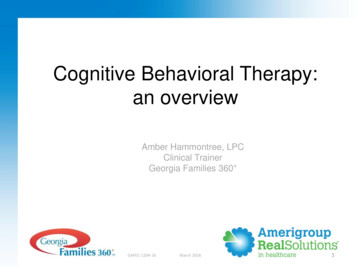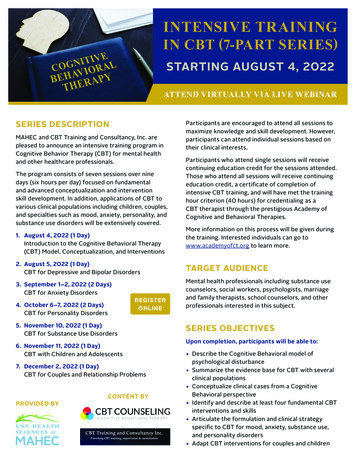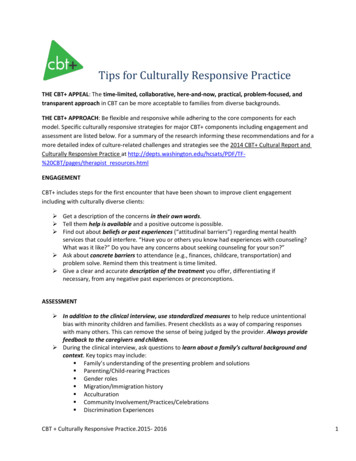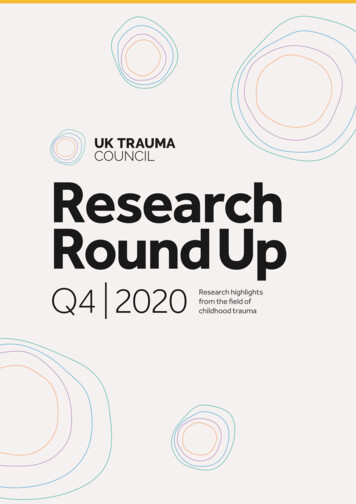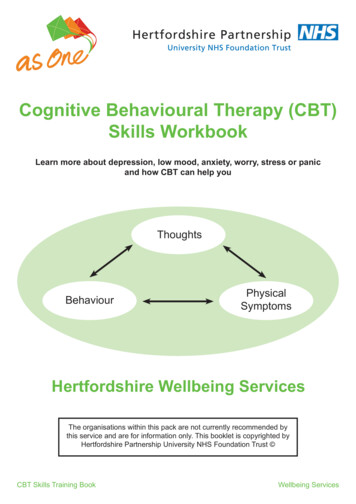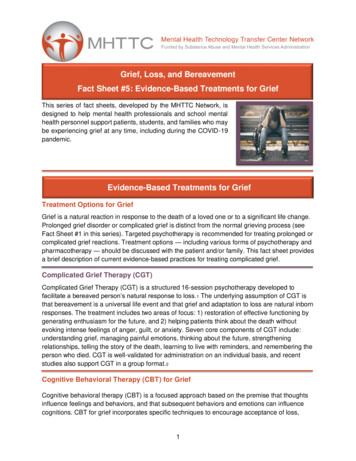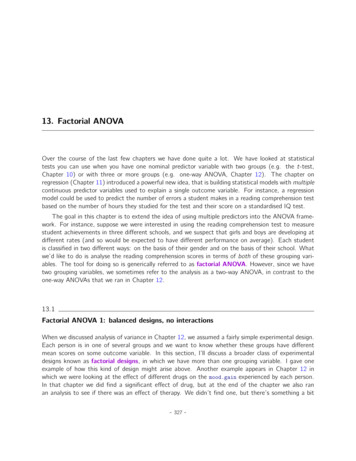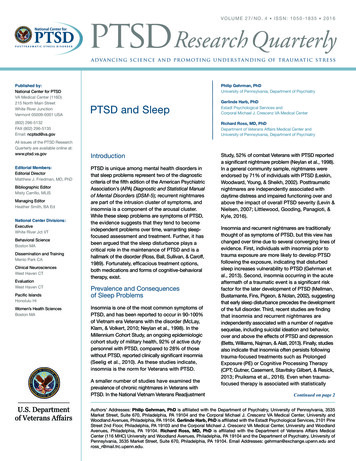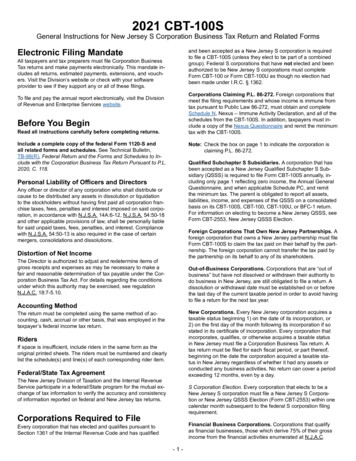
Transcription
2021 CBT-100SGeneral Instructions for New Jersey S Corporation Business Tax Return and Related FormsElectronic Filing Mandateand been accepted as a New Jersey S corporation is requiredto file a CBT-100S (unless they elect to be part of a combinedgroup). Federal S corporations that have not elected and beenauthorized to be New Jersey S corporations must completeForm CBT-100 or Form CBT-100U as though no election hadbeen made under I.R.C. § 1362.All taxpayers and tax preparers must file Corporation BusinessTax returns and make payments electronically. This mandate includes all returns, estimated payments, extensions, and vouchers. Visit the Division’s website or check with your softwareprovider to see if they support any or all of these filings.Corporations Claiming P.L. 86-272. Foreign corporations thatmeet the filing requirements and whose income is immune fromtax pursuant to Public Law 86-272, must obtain and completeSchedule N, Nexus – Immune Activity Declaration, and all of theschedules from the CBT-100S. In addition, taxpayers must include a copy of the Nexus Questionnaire and remit the minimumtax with the CBT-100S.To file and pay the annual report electronically, visit the Divisionof Revenue and Enterprise Services website.Before You BeginRead all instructions carefully before completing returns.Include a complete copy of the federal Form 1120-S andall related forms and schedules. See Technical Bulletin,TB-98(R), Federal Return and the Forms and Schedules to Include with the Corporation Business Tax Return Pursuant to P.L.2020, C. 118.Note: Check the box on page 1 to indicate the corporation isclaiming P.L. 86-272.Qualified Subchapter S Subsidiaries. A corporation that hasbeen accepted as a New Jersey Qualified Subchapter S Subsidiary (QSSS) is required to file Form CBT-100S annually, including only page 1 reflecting zero income, the Annual GeneralQuestionnaire, and when applicable Schedule PC, and remitthe minimum tax. The parent is obligated to report all assets,liabilities, income, and expenses of the QSSS on a consolidatedbasis on its CBT-100S, CBT-100, CBT-100U, or BFC-1 return.For information on electing to become a New Jersey QSSS, seeForm CBT-2553, New Jersey QSSS Election.Personal Liability of Officers and DirectorsAny officer or director of any corporation who shall distribute orcause to be distributed any assets in dissolution or liquidationto the stockholders without having first paid all corporation franchise taxes, fees, penalties and interest imposed on said corporation, in accordance with N.J.S.A. 14A:6-12, N.J.S.A. 54:50-18and other applicable provisions of law, shall be personally liablefor said unpaid taxes, fees, penalties, and interest. Compliancewith N.J.S.A. 54:50-13 is also required in the case of certainmergers, consolidations and dissolutions.Foreign Corporations That Own New Jersey Partnerships. Aforeign corporation that owns a New Jersey partnership must fileForm CBT-100S to claim the tax paid on their behalf by the partnership. The foreign corporation cannot transfer the tax paid bythe partnership on its behalf to any of its shareholders.Distortion of Net IncomeThe Director is authorized to adjust and redetermine items ofgross receipts and expenses as may be necessary to make afair and reasonable determination of tax payable under the Corporation Business Tax Act. For details regarding the conditionsunder which this authority may be exercised, see regulationN.J.A.C. 18:7-5.10.Out-of-Business Corporations. Corporations that are “out ofbusiness” but have not dissolved or withdrawn their authority todo business in New Jersey, are still obligated to file a return. Adissolution or withdrawal date must be established on or beforethe last day of the current taxable period in order to avoid havingto file a return for the next tax year.Accounting MethodNew Corporations. Every New Jersey corporation acquires ataxable status beginning 1) on the date of its incorporation, or2) on the first day of the month following its incorporation if sostated in its certificate of incorporation. Every corporation thatincorporates, qualifies, or otherwise acquires a taxable statusin New Jersey must file a Corporation Business Tax return. Atax return must be filed for each fiscal period, or part thereof,beginning on the date the corporation acquired a taxable status in New Jersey regardless of whether it had any assets orconducted any business activities. No return can cover a periodexceeding 12 months, even by a day.The return must be completed using the same method of accounting, cash, accrual or other basis, that was employed in thetaxpayer’s federal income tax return.RidersIf space is insufficient, include riders in the same form as theoriginal printed sheets. The riders must be numbered and clearlylist the schedule(s) and line(s) of each corresponding rider item.Federal/State Tax AgreementThe New Jersey Division of Taxation and the Internal RevenueService participate in a federal/State program for the mutual exchange of tax information to verify the accuracy and consistencyof information reported on federal and New Jersey tax returns.S Corporation Election. Every corporation that elects to be aNew Jersey S corporation must file a New Jersey S Corporation or New Jersey QSSS Election (Form CBT-2553) within onecalendar month subsequent to the federal S corporation filingrequirement.Corporations Required to FileFinancial Business Corporations. Corporations that qualifyas financial businesses, those which derive 75% of their grossincome from the financial activities enumerated at N.J.A.C.Every corporation that has elected and qualifies pursuant toSection 1361 of the Internal Revenue Code and has qualified-1-
18:7-1.16(a)1 through (a)7, must file the New Jersey CorporationBusiness Tax Return for Banking and Financial Business, FormBFC-1 or the Corporation Business Tax Combined Return, FormCBT-100U.combined group on a separate return (Form CBT-100S) unlessthe taxpayer joined a second combined group that files a NewJersey combined return. The taxpayer filing a separate returnwould not report the income on Form CBT-100S for the monthsduring which the member was part of the combined group. If determining what amount of income is attributable to the portionsof the twelve-month period are for the periods before and afterdeparting a combined group, the taxpayer must prorate their income/losses and receipts.Professional Corporations. Corporations formed underN.J.S.A. 14A:17-1 et seq. or any similar laws of a possession orterritory of the US, a state, or political subdivision thereof, mustcomplete Schedule PC. Examples of licensed professionalsinclude certified public accountants, architects, optometrists,professional engineers, land surveyors, land planners, chiropractors, physical therapists, registered professional nurses, dentists,osteopaths, physicians and surgeons, doctors of medicine, doctors of dentistry, podiatrists, veterinarians, and attorneys.When to File2021 Accounting Periods and Due DatesThe 2021 S Corporation Business Tax return should only beused for accounting periods ending on and after July 31, 2021,through June 30, 2022.Inactive Corporations. Inactive corporations that, during theperiod covered by the return, did not conduct any business, didnot have any income, receipts or expenses, did not own anyassets, did not make any distributions, and did not have anychange in ownership, must complete the Certificate of Inactivitysection on page 1. Payment for the related minimum tax liabilityand the installment payment (if applicable) must be submittedelectronically. See the Page 1 section for more information.In general, the New Jersey Corporation Business Tax returnsand payments, except estimated payments, are due 30 daysafter the original due date of the federal corporate income taxreturn. For the administrative convenience of both the Divisionand taxpayers, returns filed by S Corporations the 15th day ofthe fourth month following the close of the privilege period areconsidered timely even if that date is more than 30 days after thefederal due date. If the due date falls on a weekend or a legalholiday, the return and payment are due on the following business day. Use the following schedule for 2021 CBT-100S formsand payments:Combined ReportingNew Jersey enacted mandatory combined reporting for unitarybusinesses for tax years ending on and after July 31, 2019.Groups of companies that have common ownership and are engaged in a unitary business, where at least one member of thegroup is subject to the New Jersey Corporation Business Tax,are required to calculate their tax liability on a combined basis onForm CBT-100U, Combined Corporation Business Tax Return.If accountingJuly 31,period ends on:2021Due date forNov. 15,filing is:2021If accountingJan. 31,period ends on:2022Due date forMay 15,filing is:2022A New Jersey S Corporation is not included as a member of acombined group unless the New Jersey S Corporation affirmatively elects to be included as a member of the combined groupon the CBT-100U.Aug. 31, Sept. 30, Oct. 31, Nov. 30, Dec. 31,20212021202120212021Dec. 15, Jan. 15, Feb. 15, Mar. 15, Apr 15,20212022202220222022Feb. 28, Mar. 31, Apr. 30, May 31, June 30,20222022202220222022June 15, July. 15, Aug. 15, Sept. 15, Oct. 15,20222022202220222022Calendar or fiscal accounting year is the same accounting period upon which the taxpayer is required to report to the UnitedStates Treasury Department for federal income tax purposes.Please note the ending month of the accounting period forfederal returns and New Jersey returns must match, however,the tax return year for the federal and State returns may differ.(i.e., a tax year ending 8/31/21 may be filed on a 2020 federal1120-S; the same tax year must be filed on a 2021 New JerseyCBT-100S.) All accounting periods must end on the last day ofthe month, except that taxpayers may use the same 52-53 weekaccounting year that is used for federal income tax purposes,see N.J.A.C. 18:7-2.3. The Division is aware that taxpayerscannot properly input dates for 52-53 week accounting years. Inthis case, taxpayers will need to contact the Division for assistance. Returns for prior tax years are available on the Division’swebsite.Note: The law change did not impact the treatment of parentNew Jersey S Corporations and New Jersey QualifiedSubchapter S Subsidiaries. The parent of New JerseyQualified Subchapter S Subsidiary(ies) must include thefigures from itself and all the New Jersey QSSSs.A member of a combined group filing a New Jersey combinedreturn does not have to file a separate return for the privilegeperiod or portion of the privilege period thereof that the taxpayerwas included as a member of the combined return. A combinedgroup member with business operations that are independentof the unitary business activity of the combined group must report such income on Schedule X. Schedule X is submitted withthe combined return. The member will not complete a separatereturn.Visit the Division’s website for information about combinedreporting.Extension of Time to FileNote: A taxpayer that has nexus with New Jersey that is part ofa combined group or affiliated group, but excluded fromthe New Jersey combined return must file a separatereturn.The Tentative Return and Application for Extension of Time toFile, Form CBT-200-T, must be filed and paid electronically.You can also check with your software provider to see if thesoftware you use supports filing of extensions. If an extension isrequested, the corporation should notify all shareholders of suchrequestFormer Member of Combined Group. A taxpayer that wasa member of a combined group filing a New Jersey combinedreturn for part of the group privilege period and subsequentlydeparts the combined group to file on a separate entity basis,must report the income for months subsequent to departing theCorporations will automatically receive a six-month extensiononly if they have paid at least 90% of the tax liability and timelyfiled Form CBT-200-T.-2-
Late Filing Penalty. 5% per month or part of a month on theamount of underpayment not to exceed 25% of that underpayment, except if no return has been filed within 30 days of thedate on which the first notice of delinquency in filing the returnwas sent, the penalty will accrue at 5% per month or part of amonth of the total tax liability not to exceed 25% of such tax liability. Also, a penalty of 100 for each month the return is delinquent may be imposed.An extension of time is granted only to file your New Jersey Corporation Business Tax return. There is no extension of time topay the tax due. The Division will notify you only if we deny yourextension request, but not until after you actually file your return.Penalties and interest are imposed whenever tax is paid afterthe original due date.Note: An extension payment must include any applicable professional Corporation (PC) fees and/or installment payments. See the online application for more information.Late Payment Penalty. 5% of the balance of tax due paid afterthe due date for filing the return may be imposed.Payment of TaxInterest. The annual interest rate is 3% above the average predominant prime rate on outstanding balances for every monthor part of a month the tax is unpaid, compounded annually. Atthe end of each calendar year, any tax, penalties, and interestremaining due will become part of the balance on which interestwill be charged. The interest rates assessed by the Division ofTaxation are published online.The balance of tax due must be paid in full by the original duedate of the return.In addition, corporations are required to make installment payments of estimated tax. The requirement for making these payments is based on the amount of the total tax liability shown onthe most recent return.Note: The average predominant prime rate is the rate as determined by the Board of Governors of the Federal ReserveSystem, quoted by commercial banks to large businesseson December 1st of the calendar year immediately preceding the calendar year in which payment was due or asredetermined by the Director in accordance with N.J.S.A.54:48-2. If the 2021 total tax liability is greater than 375, the taxpayer must make installment payments towards 2022. Thesepayments are to be made electronically on Form CBT-150and are due on or before the 15th day of the 4th, 6th, 9th, and12th months of the tax year. Taxpayers with gross receiptsgreater than or equal to 50,000,000 must make installmentpayments on the 15th day of the 4th, 6th, and 12th months ofthe tax year.Collection Fees. In addition, if the tax bill is sent to our collection agency, a referral cost recovery fee of 11% of any tax, penalty, and interest due will be added to the liability in accordancewith N.J.S.A. 54:49-12.3. If a certificate of debt is issued for theoutstanding liability, a fee for the cost of collection of the tax mayalso be imposed. If the 2021 total tax liability is 375 or less, installmentpayments may be made as indicated above OR in lieu ofmaking installment payments, the taxpayer may make a payment of 50% of the 2021 total tax liability.How to PayUnderpayment of Estimated Tax. To calculate the amount ofinterest for the underpayment of estimated tax, complete eitherForm CBT-160-A or Form CBT-160-B. If the taxpayer qualifiesfor any of the exceptions to the imposition of interest for any ofthe installment payments, Part II must be completed and submitted with the return as evidence of such exception.To make payments electronically, go to the Division of Taxation’swebsite. Taxpayers that do not have access to the internet maycall the Division’s Customer Service Center at (609) 292-6400.Taxpayers with a prior year liability of 10,000 or more inany tax are required to make their payments for all taxes byElectronic Funds Transfer (EFT). For information or to enrollin the program, visit the Division of Revenue and EnterpriseServices’ website, call (609) 292-9292 and select option #6,fax (609) 984-6681, or write to NJ Division of Revenue andEnterprise Services, EFT Section, PO Box 191, Trenton, NJ08646-0191.Civil Fraud. If any part of an assessment is due to civil fraud,there shall be added to the tax an amount equal to 50% of theassessment in accordance with N.J.S.A. 54:49-9.1.Transacting Business Without a Certificate of Authority. Inaddition to any other liabilities imposed by law, a foreign corporation that transacts business in this State without a certificate ofauthority shall forfeit to the State a penalty of not less than 200,nor more than 1,000 for each calendar year, not more than 5years prior thereto, in which it shall have transacted business inthis State without a certificate of authority. N.J.S.A. 14A:13-11(3).Note: Taxpayers who are required to remit payments by EFTcan satisfy the EFT requirement by making e-check orcredit card payments.Penalties and InterestAmended ReturnsInsufficiency Penalty. If the amount paid with the Tentative Return, Form CBT-200-T, is less than 90% of the tax liability computed on Form CBT-100S, or in the case of a taxpayer whosepreceding return covered a full 12-month period, is less than theamount of the tax computed at the rates applicable to the currentaccounting year but on the basis of the facts shown and the lawapplicable to the preceding accounting year, the taxpayer maybe liable for a penalty of 5% per month or part of a month not toexceed 25% of the amount of underpayment from the originaldue date to the date of actual payment.Beginning with returns for Tax Year 2019 and after, taxpayersmust submit amended returns electronically.Final Determination of Net Income by Federal Government.Any change or correction made by the Internal Revenue Service must be reported to the Division within 90 days. AmendedNJ-K-1s must be provided to the appropriate shareholders.-3-
Page 1 Line-by-Line InstructionsJersey, there is no tax imposed. However, minimum tax requirements apply.Enter the federal employer identification number, New Jerseycorporation number, corporation name and complete addressand ZIP Code in the space provided on the return.Line 3 – Tax CreditsEnter amount from Schedule A-3, Part I, line 28. Include the applicable credit form(s) with the return. See Schedule A-3 instructions for more information.Check the appropriate box to indicate whether this is the initialreturn or an amended return.Line 4 – Tax LiabilitySubtract line 3 from line 2. If this amount is less than 1,500,complete Schedule A-GR to determine if there is a minimum taxliability. (Members of affiliated groups, see the instructions forSchedule A-GR.) Enter the greater of the computed tax liabilityor the amount from Schedule A-GR, line 7.If filing an amended return, enter the applicable codein the boxes provided. If using code 10, “Other,” enterthe reason in the lines provided. If more space isneeded, include a rider.1.2.3.4.5.6.7.8.9.10.Change in allocation factorIRS auditAmended federal 1120 filedTo take credit for payments/payments made by apartnershipAdjustments to ENITo change credit request to refund request or refundrequest to credit requestChange in filing periodChange in tax credits reportedAdding or subtracting a combined return memberOtherNote: The surtax does not apply to New Jersey S corporations.Line 5 – Installment PaymentTaxpayers are required to make installment payments of estimated tax. The requirement for making these payments is basedon the amount of the total tax liability shown on the most recentreturn. If the 2021 total tax liability is greater than 375, the taxpayer must make installment payments towards 2022. Thesepayments are to be made electronically on Form CBT-150and are due on or before the 15th day of the 4th, 6th, 9th, and12th months of the tax year. Taxpayers with gross receiptsgreater than or equal to 50,000,000 must make installmentpayments on the 15th day of the 4th, 6th, and 12th months ofthe tax year. Information on making these payments can befound on the Division’s website.Provide the remaining information requested on the top portionof the return. The federal business activity code should be takenfrom the taxpayer’s federal tax return. Provide the location of thecorporate books as well as a contact person and telephone number. If the corporation is a Professional Corporation, is claimingP.L. 86-272, or is a Qualified Subchapter S Subsidiary, check thebox. See Corporations Required to File on page 1 for requiredforms and schedules. If the 2021 total tax liability is 375, installment paymentsmay be made as indicated above OR in lieu of making installment payments, the taxpayer may make a payment of 50%of the 2021 total tax liability. For taxpayers who qualify andwant to take advantage of this option, enter on line 5, 50% ofthe amount on line 4. This will become part of the payment tobe made with the 2021 return and installment payments willnot be required. This payment should be claimed as a creditwhen filing the 2022 return.All corporations must complete page 1, the Annual GeneralQuestionnaire, and Schedules A, A-2, A-3, A-4, and A-GR of thereturn.Line 1 – Taxable Net Income Subject to Federal CorporateIncome TaxationEnter amount from Schedule A, Part II, line 5. If zero or less,enter zero.Line 6 – Professional Corporation FeesEnter amount from Schedule PC, Part II, line 7.Line 2 – Amount of TaxMultiply line 1 by the applicable tax rate:Note: Check the box on page 1 to indicate the corporation is aProfessional Corporation. If the total of Schedule A, Part II, line 5 plus Schedule O,Part III, line 31 (if applicable) is greater than 100,000, thetax rate is 9% (.09).See Schedule PC instructions for information about filing requirements and examples of professional corporations. If the total of Schedule A, Part II, line 5 plus Schedule O,Part III, line 31 (if applicable) is greater than 50,000 andless than or equal to 100,000, the tax rate is 7.5% (.075).Tax periods of less than 12 months qualify for the 7.5% rateif the prorated total of Schedule A, Part II, line 5 plus Schedule O, Part III, line 31 does not exceed 8,333 per month.Line 7 – Total Tax and Professional Corporation FeesEnter the total of lines 4, 5, and 6.Line 8a – Payments and CreditsInclude on this line: Installment tax payments made for 2021; If the total of Schedule A, Part II, line 5 plus Schedule O,Part III, line 31 (if applicable) is 50,000 or less, the taxrate is 6.5% (.065). Tax periods of less than 12 months qualifyfor the 6.5% rate if the prorated total of Schedule A, Part II,line 5 plus Schedule O, Part III, line 31 does not exceed 4,166 per month. Amounts paid with tentative return (form CBT-200-T); Any overpayment from the preceding tax return that the taxpayer elected to have credited to the current year’s tax. Donot include any amount of the overpayment that the taxpayerelected to have refunded.Note: Professional corporation installment payments from theprior year may not be used to offset any current year taxliability and are not eligible for refund.For taxpayers with total entire net income that is not subject tofederal income taxation or such portion that is allocable to New-4-
Line 17 – Credit to a Combined GroupEnter the amount of your overpayment that you want to credit toa combined group. Also include the unitary ID Number and taxreturn year to which it is to be applied.Line 8b – Payments Made by PartnershipsInclude the total payments made by partnerships on behalf ofthe taxpayer that are reported in column 7 on Schedule P-1.Submit copies of the NJK-1s or K-1s (as applicable) reflectingpayments made by each partnership entity.Note: An overpayment of tax by a New Jersey S corporationcan only be credited to a combined group in which theNew Jersey S corporation elects to be included. Otherwise, an overpayment of tax by a New Jersey S corporation will not be credited to any combined group.Line 8c – Refundable Tax CreditsEnter the amount from Schedule A-3, Part II, line 5. Include theapplicable credit form(s) with the return. See Schedule A-3 instructions for more information.Line 9 – Balance of Tax DueIf line 8d is less than line 7, subtract line 8d from line 7 and enterthe difference. If line 8d is more than line 7, skip line 9 and continue with line 10.Certification of InactivityInactive corporations must complete page 1, the Annual GeneralQuestionnaire, and Schedules A, A-2, A-3, A-4, and A-GR of theCBT-100S. A corporate officer must sign and certify that the corporation did not conduct any business, did not have any income,receipts, or expenses, and did not own any assets during theentire period covered by the tax return.Line 10 – Pro Rata Share of S Corp Income for Nonconsenting ShareholdersEnter the amount from Schedule K, Part VII, line 6, column C. Ifthe S corporation was completely liquidated during the tax yearand Schedule K Liquidated was completed, add the amountsfrom Part VII, line 6 columns C and E and enter the total.SignatureEach return must be signed by an officer of the corporation whois authorized to attest to the truth of the statements containedtherein and to acknowledge that they understand they are required to include copies of their federal return(s), forms, andschedules. The fact that an individual’s name is signed on thereturn shall be prima facie evidence that such individual is authorized to sign the return on behalf of the corporation.Line 11 – Gross Income Tax Paid on Behalf of Nonconsenting ShareholdersEnter the amount from Schedule K, Part VII, line 6, column F. Ifthe S corporation was completely liquidated during the tax yearand Schedule K Liquidated was completed, enter the amountfrom Part VII, line 6, column H. The tax rate on net pro ratashare of S corporation income allocated to New Jersey for nonconsenting shareholders is 10.75% (.1075).Tax preparers who fail to sign the return or provide their assigned tax identification number shall be liable for a 25 penaltyfor each such failure. If the tax preparer is not self-employed,the name of the tax preparer’s employer and the employer’s taxidentification number should also be provided. In the case of acorporation in liquidation or in the hands of a receiver or trustee,certification shall be made by the person responsible for the conduct of the affairs of such corporation.Note: The S corporation cannot make payments on behalf ofconsenting shareholders. Any payments made on behalfof consenting shareholders will be disallowed by the Division. The S corporation will be required to file a refundclaim for any payments made on behalf of consentingshareholders.Annual General QuestionnaireLine 12 – Penalty and Interest DueInclude any penalties and interest. See the Penalties and Interest section for information.All taxpayers must answer all questions on this schedule. If necessary, include a rider detailing the information requested in thequestions.Amount Due or Overpayment - Lines 13–17Compare line 8d to the total of lines 7, 11, and 12.Schedule A If line 8d is less than the total of lines 7, 11, and 12, completeline 13.Computation of Taxable Net Income If line 8d is more than the total of lines 7, 11, and 12, complete lines 14 through 17.Every taxpayer must complete this schedule.Taxpayers must include a copy of the federalreturn and any forms or schedules that accompanied the return that was filed with the Internal Revenue Service. Failure to include the forms andschedules will result in an incomplete New Jersey Corporation Business Tax return and the taxpayer may be assessedpenalties and interest for noncompliance. See Technical Bulletin, TB-98, Federal Return and the Forms and Schedules toInclude with the Corporation Business Tax Return Pursuantto P.L. 2020, C. 118.Line 13 – Total Balance DueEnter the total of lines 9, 11, and 12.Line 14 – Amount OverpaidSubtract the total of lines 7, 11, and 12 from the amount online 8d.Line 15 – RefundEnter the amount of your overpayment that you want refunded.Line 16 – Credit to 2022Enter the amount of your overpayment that you want to credit toyour 2022 tax liability.Part ILine 4 – Net gain (loss) from Form 4797Include a rider or schedules showing the same informationshown on federal Form 4797. Gains and losses resultingfrom the disposition of property where a I.R.C. § 179 expense-5-
Line 36b – Depreciation modification being subtracted fromincomeEnter the depreciation and other adjustments being subtractedfrom income from Schedule S. See Schedule S instructions formore information.deduction was passed through to S corporation shareholders arenot reported on federal Form 4797, and should be reported onSchedule A, Part I, line 26. If a sale of shares of stock or partnership interest resulted in a taxable transfer of a controlling interestin certain commercial real property under N.J.S.A. 54:15C-1,indicate on a rider.Line 37a – I.R.C. § 78 Gross-upThe portion of any I.R.C. § 78 gross-up included in dividendincome on Part I, line 23b that is not excluded/deducted fromentire net income on Part I, line 43 may be deducted on this line.Include a copy of federal foreign tax credit, Form 1118.Line 13 – InterestInclude a copy of federal Form 8916A and/or federal Form 8990if completed.Lines 22a to 30 – Include all items of income and expense thatpass through to the individual shareholders as reported on thefederal Schedule K. Be sure to report Part I, lines 26, 27, and 28as deductions.Line 37b – Other deductions and additionsThis includes, but is not limited to: Adjustments for which a place has not been provided somewhere else on the return;Charitable contributions are limited to 10% of taxable incomefor New Jersey purposes and should be stated separately online 30. Gross income, less deductions and expenses in connectionwith that income, from sources outside the United States notincluded in federal taxable income,Built-in gains must be reported on Part I, line 23d as a grossamount exclus
For information on electing to become a New Jersey QSSS, see Form CBT-2553, New Jersey QSSS Election. Foreign Corporations That Own New Jersey Partnerships. A foreign corporation that owns a New Jersey partnership must file Form CBT-100S to claim the tax paid on their behalf by the part-nership. The foreign corporation cannot transfer the tax .
